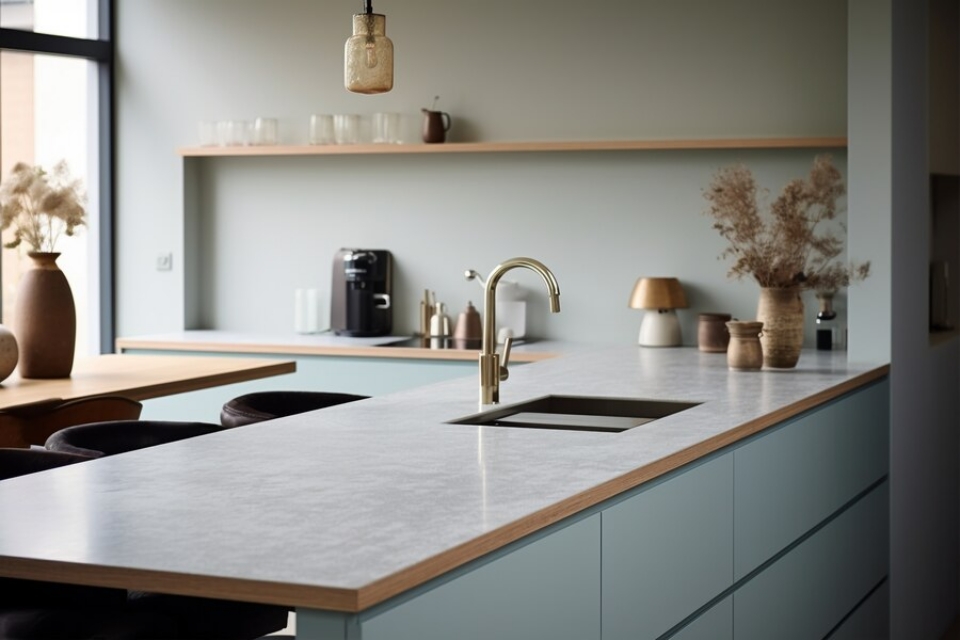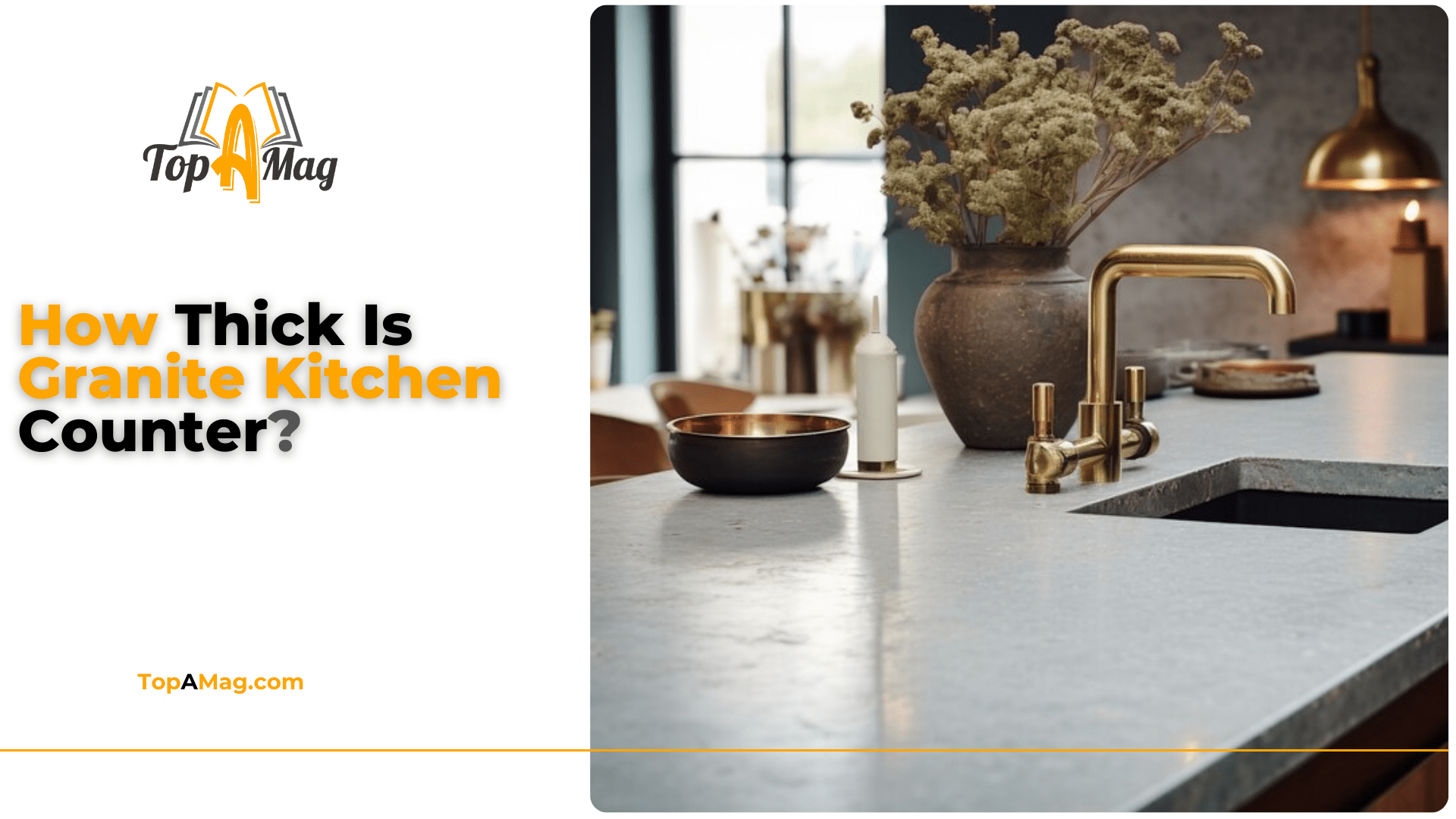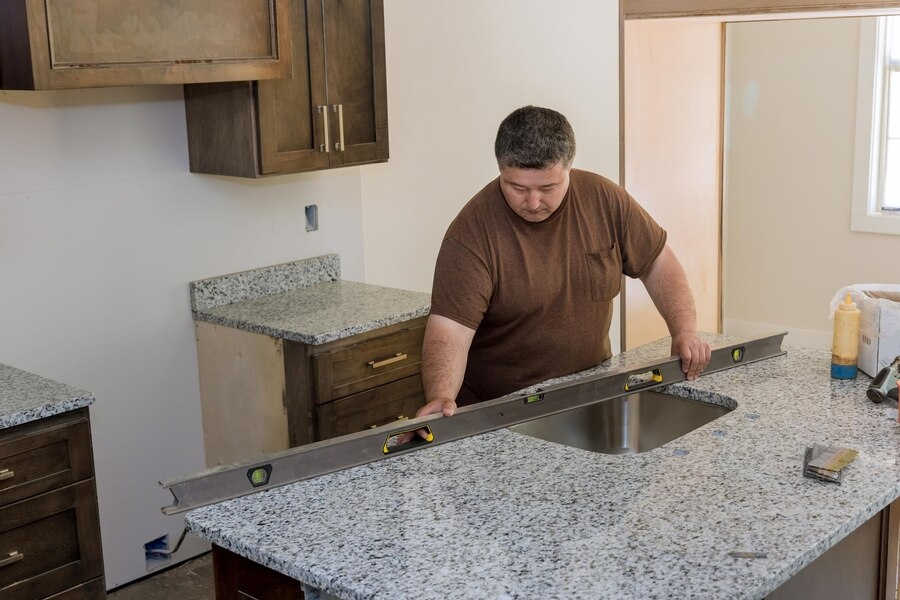Granite kitchen counters have long been a hallmark of elegance and durability in homes worldwide. But have you ever wondered just how thick these stunning surfaces are? Understanding the dimensions of your countertop can significantly impact your kitchen’s aesthetics and functionality.
In this comprehensive guide, we’ll delve into the intricacies of granite thickness, exploring the various options available, the benefits and drawbacks of each, and how to make the best choice for your kitchen.
Key Takeaways
- Standard thicknesses are 2 cm, 3 cm, and 6 cm, each offering distinct advantages and considerations.
- The thickness of granite influences both the look and durability of your countertop.
- Thicker granite typically costs more but offers greater strength and longevity.
- Higher-quality granite is more versatile and visually appealing, even in thinner profiles.
- Opt for sustainably sourced granite to minimize environmental impact.

Standard Thickness of Granite Kitchen Counter
Granite countertops typically come in three standard thicknesses: 2 cm, 3 cm, and 6 cm. Each thickness offers unique benefits and potential drawbacks.
2 cm Granite Kitchen Counter:
- Appearance and Usage: This thinner option provides a sleek, modern look. It’s often used in bathrooms or for vertical surfaces like backsplashes.
- Support Requirements: Due to its thinner profile, it usually requires additional support, such as plywood backing or metal rods, to prevent sagging.
- Cost: Generally more affordable than thicker options, making it an attractive choice for budget-conscious renovations.
3 cm Granite Kitchen Counter:
- Appearance and Usage: This is the most common thickness for kitchen countertops, providing a balanced look that complements both traditional and contemporary designs.
- Durability: Offers greater strength and doesn’t typically need additional support, making it a more practical choice for high-traffic kitchens.
- Cost: More expensive than 2 cm granite but often worth the investment due to its durability and aesthetic appeal.
6 cm Granite Kitchen Counter:
- Appearance and Usage: This ultra-thick option is less common and usually reserved for a high-end, custom kitchen. It creates a bold, luxurious statement.
- Support Requirements: Extremely sturdy and self-supporting, although its weight can be a challenge during installation.
- Cost: Significantly more expensive, reflecting its premium nature and the complexity of installation.
Factors to consider for Granite Kitchen Counter Thickness
When deciding how thick your granite kitchen counter should be, several factors come into play.
Kitchen Design and Style:
- Modern vs. Traditional: Sleek, modern kitchens may benefit from thinner granite for a streamlined look, while traditional kitchens often favor the robustness of 3 cm granite.
- Complementary Elements: Consider your cabinetry and overall kitchen decor. Heavier countertops need sturdy cabinets to support them, while lighter ones can be more versatile.
Functionality:
- Usage Frequency: Kitchens that see heavy use benefit from thicker, more durable granite. A chef’s kitchen, for example, should ideally opt for 3 cm or even 6 cm granite.
- Maintenance: Thicker granite countertops generally require less maintenance and are less prone to damage from everyday activities.
Budget Considerations for Granite Kitchen Counter:
- Initial Investment vs. Long-term Value: While 3 cm granite costs more upfront, its longevity and resilience often make it a better long-term investment compared to 2 cm granite.
Installation Challenges and Considerations
Installing a granite countertop involves more than just choosing the thickness. Here are some critical aspects to consider:
Weight and Support:
- Structural Support: Thicker granite, especially 6 cm, requires robust cabinetry to handle its weight. Ensure your kitchen structure can support the load.
- Installation Process: Heavier slabs are more challenging to handle and install. Professional installation is recommended to avoid damaging the granite or your kitchen.
Seams and Edging:
- Seam Visibility: Thicker granite may have fewer seams, offering a more seamless look. However, when seams are necessary, professional installers can make them less noticeable.
- Edge Profiles: Different thicknesses allow for various edge profiles. Thicker granite provides more options, from simple eased edges to elaborate ogee designs.
The Role of Quality
The quality of the granite also plays a significant role in determining the appropriate thickness. Higher-quality granite is more durable and less prone to imperfections, allowing for a broader range of thickness options without sacrificing performance.
Grading System:
- Level 1 (Entry-Level): Often thinner and used in less demanding applications.
- Level 2 (Mid-Range): Balanced quality and thickness, suitable for most kitchen countertops.
- Level 3 (High-End): Premium granite, usually thicker, with unique patterns and colors.
Visual and Structural Integrity:
- Aesthetics: High-quality granite offers more vibrant colors and intricate patterns, making thicker slabs more visually appealing.
- Strength: Superior granite is structurally sound even in thinner profiles, though 3 cm remains the most versatile choice for its combination of strength and aesthetics.
Considerations for Granite Kitchen Counter
As sustainability becomes increasingly important, the environmental impact of your granite kitchen counter is worth considering.
Sourcing and Quarrying:
- Sustainable Practices: Opt for granite sourced from quarries that follow sustainable practices, reducing the environmental footprint.
- Local vs. Imported: Local granite reduces transportation emissions, though imported granite may offer unique aesthetics not available locally.
Durability and Lifespan:
- Longevity: Thicker granite countertops have a longer lifespan, reducing the need for replacements and thus lowering long-term environmental impact.
- Maintenance: Proper care and maintenance extend the life of your granite, making it a more sustainable choice over time.
Making the Final Decision
Choosing the right thickness for your granite kitchen counter depends on balancing aesthetics, functionality, and budget. Here are some final tips to help you decide:
Assess Your Needs:
- Cooking Habits: If your kitchen is a bustling hub of activity, prioritize durability with thicker granite.
- Design Preferences: Match the countertop thickness to your kitchen’s style and existing decor.
Consult Professionals:
- Expert Advice: Kitchen designers and granite suppliers can offer valuable insights into the best thickness for your specific needs.
- Installation Teams: Professional installers ensure that your chosen granite is fitted correctly, maximizing both its beauty and functionality.
Frequently Asked Questions (FAQs)
1. What is the most common thickness for granite kitchen countertops?
The most common thickness is 3 cm. It offers a balanced look and durability, making it suitable for most kitchen designs and heavy usage.
2. Do I need additional support for a 2 cm granite countertop?
Yes, 2 cm granite typically requires additional support, such as plywood backing or metal rods, to prevent sagging and ensure stability.
3. Is thicker granite more durable?
Generally, yes. Thicker granite (like 3 cm and 6 cm) is more durable and less prone to damage, making it ideal for high-traffic areas and heavy use.
4. How does granite thickness affect installation?
Thicker granite is heavier and more challenging to install. Professional installation is recommended to handle the weight and ensure proper support.
5. Can I choose thinner granite for a modern kitchen design?
Absolutely. 2 cm granite can provide a sleek, modern look, especially for vertical applications or in spaces where a lighter aesthetic is desired.
Conclusion
Understanding the thickness of granite kitchen counters is crucial for making an informed decision that enhances both the beauty and functionality of your kitchen. Whether you opt for the sleek 2 cm, the balanced 3 cm, or the bold 6 cm, each choice comes with its unique benefits and considerations. By evaluating your kitchen’s design, usage, and budget, you can select the perfect granite thickness to create a stunning, durable workspace that will stand the test of time.



